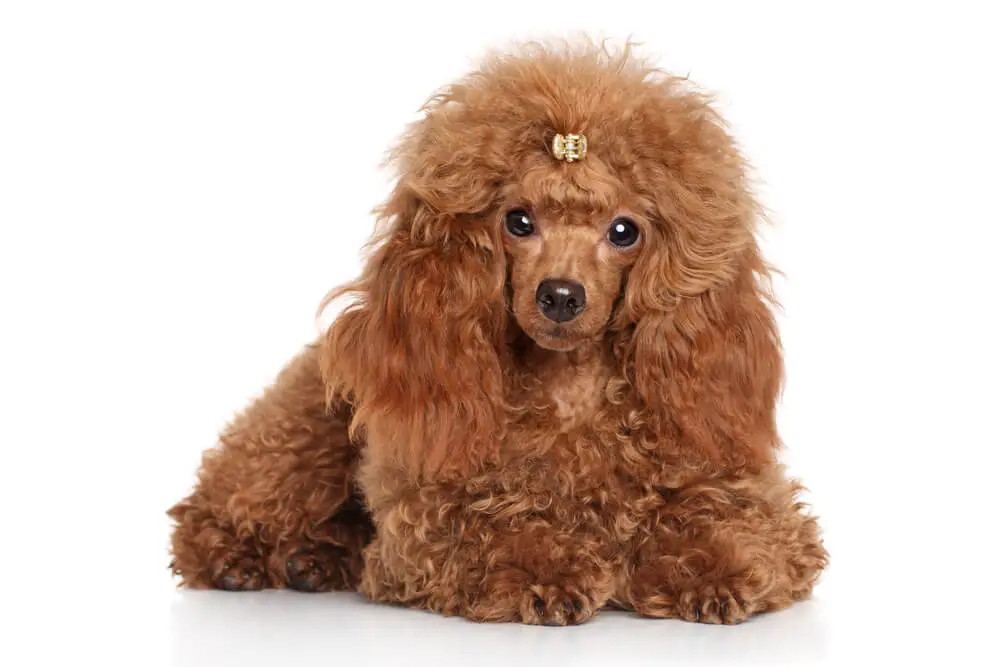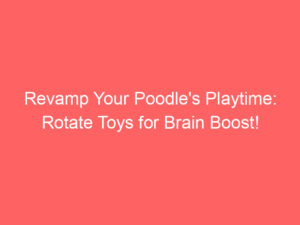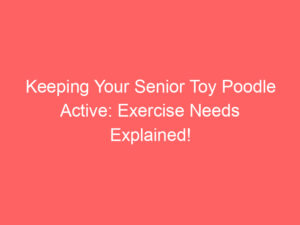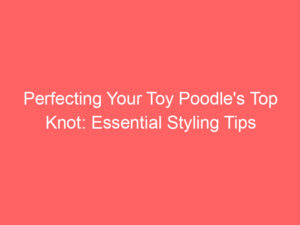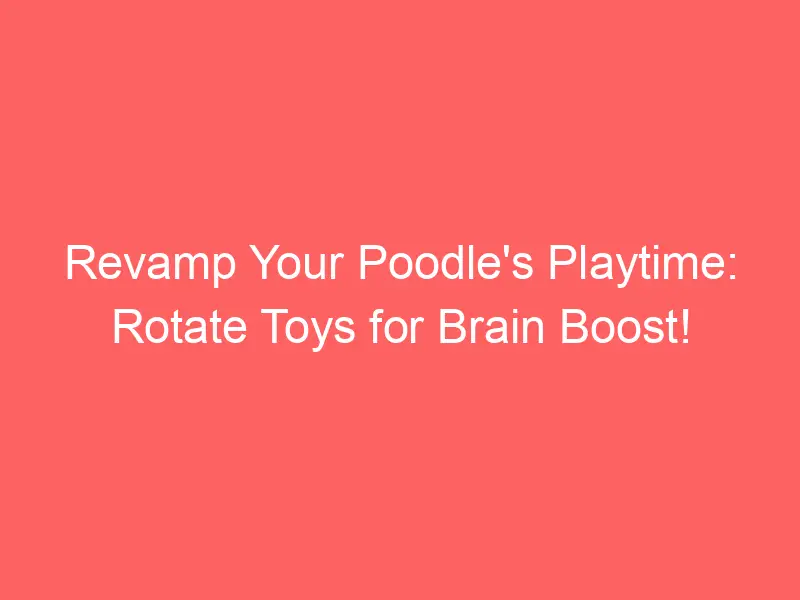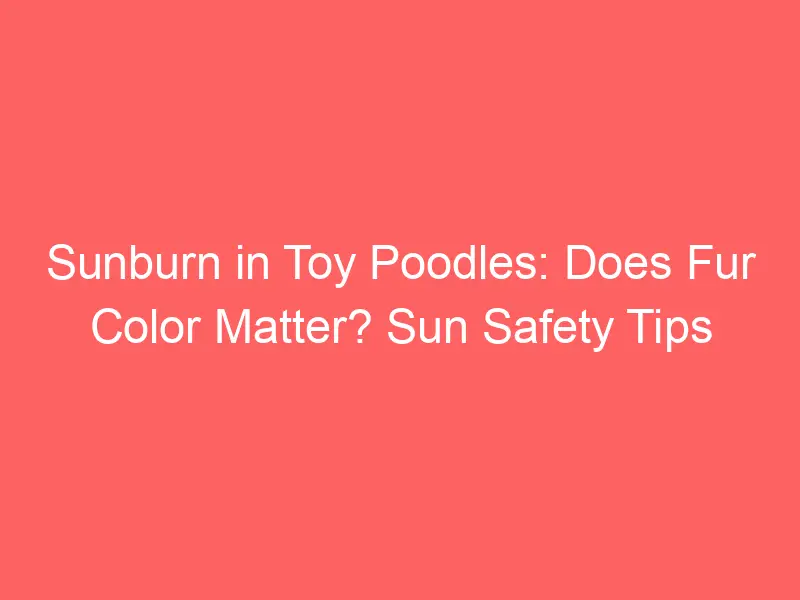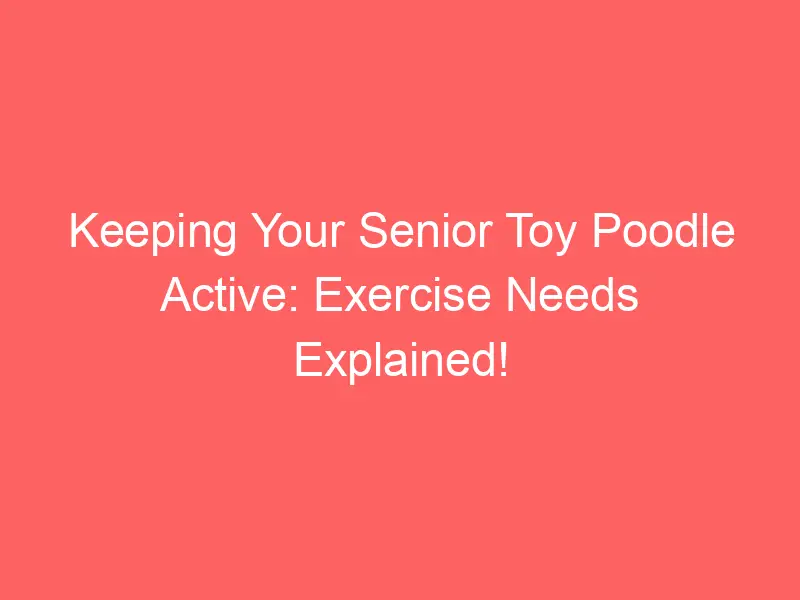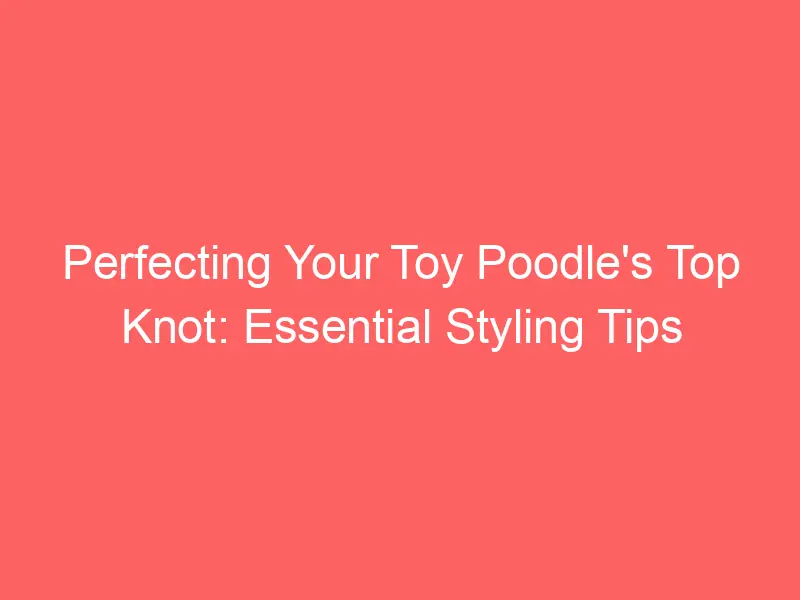Introduction to Toy Poodle Alone Time
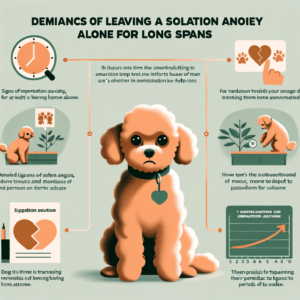
Toy Poodles, like all dogs, are social animals that thrive on interaction and companionship. However, it’s also crucial for them to spend some time alone. This time allows them to develop independence and cope with periods of solitude. In this section, we will delve into the importance of alone time for Toy Poodles and dispel some common misconceptions about leaving them alone.
-
- Understanding the Importance of Alone Time for Toy Poodles
Alone time is essential for a Toy Poodle’s development. It aids in building their confidence and independence. When a Toy Poodle is comfortable being alone, they are less likely to develop separation anxiety or destructive behaviors. It’s a time for them to relax, explore their environment, and engage in self-play. It’s also a chance for them to rest and recharge, just like humans do.
-
- Common Misconceptions about Leaving Toy Poodles Alone
Many pet owners believe that leaving their Toy Poodles alone will make them feel abandoned or unloved. This is a misconception. While Toy Poodles do enjoy companionship, they also need time to themselves. Another common myth is that Toy Poodles can’t be left alone because they will become destructive. While some dogs may exhibit destructive behavior when left alone, this is often a sign of lack of exercise or mental stimulation, not the result of being alone per se. Proper training and ensuring your Toy Poodle has plenty of toys and activities can mitigate this behavior.
In the following sections, we will further explore Toy Poodle separation anxiety, how to care for your Toy Poodle when they are home alone, and how to train them for alone time. We will also discuss how to manage their solitude and address any feelings of loneliness they may experience. Stay tuned for a comprehensive guide on balancing alone time and companionship for your beloved Toy Poodle.
Understanding Toy Poodle Separation Anxiety
Separation anxiety is a common issue among toy poodles. It’s a condition where your furry friend becomes extremely anxious when they’re left alone. Understanding the signs of this condition can help you manage it effectively and ensure your pet’s well-being.
Signs of Separation Anxiety in Toy Poodles
There are several signs that your toy poodle may be experiencing separation anxiety. These can be categorized into behavioral changes and physical symptoms.
-
- Behavioral changes when left alone: Toy poodles with separation anxiety may exhibit behavioral changes when they’re left alone. These changes can include excessive barking, chewing on furniture or other objects, and attempts to escape from the house. They may also become overly clingy when you’re home, following you around constantly and becoming distressed when they can’t see you.
- Physical symptoms of anxiety: In addition to behavioral changes, toy poodles with separation anxiety may show physical symptoms. These can include excessive drooling, panting, or even self-harm in severe cases. They may also show changes in their eating or sleeping habits, such as refusing to eat or sleep when you’re not home.
It’s important to note that these symptoms can also be signs of other health issues, so it’s crucial to consult with a vet if you notice any changes in your toy poodle’s behavior or physical condition.
Managing Toy Poodle Separation Anxiety
Separation anxiety in Toy Poodles can be a challenging issue to address. However, with the right strategies and professional help, it can be managed effectively. Let’s explore some of these methods.
-
- Training Techniques for Reducing Anxiety
Training is a powerful tool for managing separation anxiety in Toy Poodles. Here are some techniques that can help:
-
-
- Gradual Desensitization: This involves gradually increasing the time your Toy Poodle spends alone, starting from a few minutes to several hours. This helps your dog get used to being alone without feeling anxious.
- Positive Reinforcement: Reward your Toy Poodle for calm behavior when you’re about to leave and when you return. This can help them associate your departures and arrivals with positive experiences.
- Distraction: Providing your Toy Poodle with toys or treats can distract them from your absence and reduce their anxiety.
- Professional Help for Severe Cases
-
If your Toy Poodle’s separation anxiety is severe, it may be time to seek professional help. A professional dog trainer or a veterinary behaviorist can provide specialized training techniques and therapies to manage your dog’s anxiety. In some cases, medication may be recommended. Remember, it’s important to consult with a professional before starting any treatment plan.
Managing separation anxiety in Toy Poodles requires patience and consistency. With the right approach, your furry friend can learn to feel safe and secure even when you’re not around.
Toy Poodle Care When Home Alone
Leaving your Toy Poodle home alone can be a daunting task. However, with the right preparation and care, it can be a smooth process. The key is to create a safe and comfortable environment for your furry friend.
Creating a Safe Environment
Ensuring your Toy Poodle’s safety is paramount when they are home alone. Here are some tips on how to create a safe environment for your Toy Poodle:
- Safe spaces for Toy Poodles: Designate a specific area in your home where your Toy Poodle can stay. This should be a space free from hazards like electrical wires, sharp objects, and small items they could choke on. It should also be comfortable and cozy, with enough space for them to move around. A pet playpen or a gated area in your living room could work well.
- Essential items to leave with your Toy Poodle: Make sure your Toy Poodle has everything they need while you’re away. This includes fresh water, a comfortable bed, and their favorite toys. You could also consider leaving a piece of your clothing with your scent on it to comfort them. Remember, it’s important to remove any items that could be a potential choking hazard.
Creating a safe environment for your Toy Poodle when they are home alone is crucial. It not only ensures their safety but also helps reduce their anxiety and stress. Remember, a happy and safe Toy Poodle is a joy to come home to!
Keeping Your Toy Poodle Entertained
When it comes to keeping your Toy Poodle entertained while you’re away, there are several effective strategies you can employ. These methods not only keep your pet occupied but also stimulate their minds, keeping them happy and healthy.
- Interactive Toys for Toy Poodles
Interactive toys are a great way to keep your Toy Poodle entertained. These toys are designed to challenge your dog mentally and physically, keeping them engaged for extended periods. For example, puzzle toys filled with treats can keep your Toy Poodle busy as they work to retrieve the reward. Another popular choice is the Kong toy, which can be filled with peanut butter or other treats.
Remember, it’s important to rotate the toys regularly to keep your Toy Poodle interested. Always ensure that the toys are safe and suitable for your dog’s size and chewing habits.
- Music and Television for Dogs
Believe it or not, music and television can be effective tools for keeping your Toy Poodle entertained. Studies have shown that certain types of music, such as classical, can have a calming effect on dogs. You can leave music playing softly in the background to provide a soothing environment for your pet.
Similarly, television can provide visual and auditory stimulation for your Toy Poodle. There are even channels specifically designed for dogs, featuring programming that is intended to keep them entertained and relaxed.
Remember, these methods should be used in moderation and not as a substitute for physical activity and interaction. Your Toy Poodle still needs plenty of exercise and attention from you to stay happy and healthy.
Understanding Poodle Alone Duration
One of the most common questions that Toy Poodle owners have is how long their furry friends can stay alone. The answer to this question is not as straightforward as it might seem, as it depends on a variety of factors. In this section, we will delve into the details of how long a Toy Poodle can stay alone and the factors that affect this duration.
-
- How long can a Toy Poodle stay alone?
Toy Poodles are known for their intelligence and sociability, which means they thrive on interaction and companionship. As a general rule, a healthy adult Toy Poodle can stay alone for about 4 to 6 hours. However, this duration can vary depending on the individual dog’s temperament, age, and health condition. Puppies and senior dogs, for instance, require more frequent care and should not be left alone for more than 2 to 3 hours at a time. Remember, leaving your Toy Poodle alone for extended periods can lead to feelings of loneliness and even separation anxiety.
-
- Factors affecting alone time duration
Several factors can influence how long a Toy Poodle can stay alone. These include:
-
-
- Age: Puppies and older dogs need more care and attention than adult dogs. They may need to be fed more often and require more frequent bathroom breaks.
- Health: Dogs with certain health conditions may need medication or special care, which means they cannot be left alone for long periods.
- Temperament: Some Toy Poodles are more independent than others. Dogs that are more sociable or anxious may struggle more with being alone.
- Training: Dogs that have been trained to stay alone will be more comfortable and less anxious when left alone.
-
Understanding these factors can help you make informed decisions about how long to leave your Toy Poodle alone. Always remember, your dog’s wellbeing should be your top priority.
Addressing Toy Poodle Loneliness
Toy Poodles are known for their intelligence and affectionate nature. However, like any other breed, they can experience feelings of loneliness when left alone for extended periods. Understanding how to identify and address this issue is crucial for their wellbeing.
Identifying Loneliness in Toy Poodles
Recognizing the signs of loneliness in your Toy Poodle can help you take steps to alleviate their distress. These signs can be categorized into behavioral and physical symptoms.
-
- Behavioral signs of loneliness:
Changes in behavior are often the first indication that your Toy Poodle is feeling lonely. This can include excessive barking or whining, destructive behavior such as chewing on furniture, and changes in eating habits. They may also show signs of depression, such as lack of interest in play or interaction.
-
- Physical symptoms of loneliness:
Physical symptoms can also indicate loneliness in your Toy Poodle. These can include changes in sleeping patterns, loss of appetite, and excessive licking or chewing on themselves. In severe cases, loneliness can lead to stress-related health issues such as digestive problems or skin conditions.
Remember, every dog is unique, and they may exhibit different signs of loneliness. It’s essential to know your Toy Poodle well and observe any changes in their behavior or physical condition. If you notice any of these signs, it’s crucial to take action to help your furry friend feel less lonely.
Preventing Loneliness in Toy Poodles
Preventing loneliness in your toy poodle involves proactive measures. It’s not just about providing food and shelter, but also ensuring they have a fulfilling and happy life. Here are some strategies you can employ:
-
- Regular interaction and playtime
Toy poodles are known for their energetic and playful nature. Regular interaction and playtime are crucial in keeping them happy and preventing feelings of loneliness. This can involve simple activities like playing fetch, going for walks, or even teaching them new tricks. According to a study by Wikipedia, dogs who engage in regular playtime and interaction are less likely to exhibit signs of loneliness and separation anxiety.
-
- Consideration of a second pet
Another effective way to prevent loneliness in toy poodles is by considering the addition of a second pet. This could be another dog, or even a cat. Having a companion can greatly reduce feelings of loneliness when you’re not around. However, it’s important to ensure that the two pets get along well to avoid any potential conflicts. A case study by Wikipedia showed that dogs who had companions exhibited fewer signs of loneliness and separation anxiety.
In conclusion, preventing loneliness in toy poodles involves regular interaction, playtime, and potentially introducing a second pet. By taking these steps, you can ensure your toy poodle is happy, healthy, and free from feelings of loneliness.
Toy Poodle Behavior When Alone
Understanding the behavior of your toy poodle when left alone is crucial for their well-being. It helps you to identify any signs of distress and take appropriate action. Let’s delve into the common behaviors of toy poodles when they are left alone and how to interpret these behaviors.
-
- Common behaviors of Toy Poodles when left alone
Toy poodles are known for their lively and playful nature. However, when left alone, they may exhibit certain behaviors that are out of the ordinary. Here are some common behaviors:
-
-
- Barking or Whining: If your toy poodle barks or whines excessively when left alone, it could be a sign of separation anxiety. This is their way of expressing their discomfort and loneliness.
- Chewing on Furniture: Toy poodles may resort to chewing on furniture or other items in the house. This is often a sign of boredom or stress.
- Pacing: If your toy poodle is pacing back and forth, it could be a sign of anxiety or nervousness.
- Loss of Appetite: If your toy poodle is not eating well when left alone, it could be a sign of stress or anxiety.
- How to interpret these behaviors
-
Interpreting these behaviors correctly can help you provide the right care and attention for your toy poodle. Here’s what these behaviors could mean:
-
- Barking or Whining: This could be a sign of separation anxiety. Your toy poodle may feel anxious when left alone and express it through barking or whining. It’s important to address this issue to ensure your pet’s well-being.
- Chewing on Furniture: This could be a sign of boredom or stress. Providing your toy poodle with plenty of toys and mental stimulation can help mitigate this behavior.
- Pacing: This could be a sign of anxiety or nervousness. It’s important to provide a calming environment for your toy poodle when you’re not around.
- Loss of Appetite: This could be a sign of stress or anxiety. If your toy poodle is not eating well when left alone, it’s important to consult with a vet to rule out any health issues.
Understanding your toy poodle’s behavior when left alone is key to ensuring their happiness and well-being. By recognizing and addressing these behaviors, you can provide a comfortable and stress-free environment for your pet.
Toy Poodle Training for Alone Time
Training your Toy Poodle to spend time alone is an essential part of their overall development. It helps them to become independent and reduces their chances of developing separation anxiety. Here, we will discuss some effective training techniques that you can use to help your Toy Poodle become comfortable with spending time alone.
Effective Training Techniques
There are several training techniques that you can use to help your Toy Poodle get used to being alone. The key is to start slowly and gradually increase the amount of time they spend alone. This will help them to adjust to the new routine without feeling overwhelmed.
- Gradual increase in alone time: Start by leaving your Toy Poodle alone for just a few minutes at a time. Gradually increase this time over several weeks, until they are comfortable being alone for longer periods. This slow and steady approach will help your Toy Poodle adjust to their new routine without feeling overwhelmed or anxious.
- Positive reinforcement techniques: Reward your Toy Poodle for good behavior when they are alone. This could be a treat, a favorite toy, or even just some extra attention when you return. This will help them to associate being alone with positive experiences, making them more likely to be comfortable when left alone in the future.
Remember, every dog is unique and what works for one may not work for another. It’s important to be patient and consistent with your training. With time and practice, your Toy Poodle will learn to enjoy their alone time and you’ll have peace of mind knowing they’re comfortable and content.
Professional Training Options
While there are many ways to train your Toy Poodle for alone time, professional training is a viable option that offers numerous benefits. Let’s explore the advantages of professional training and how to select the right trainer for your furry friend.
-
- Benefits of Professional Training
Professional training can provide a structured environment for your Toy Poodle to learn important skills. Trainers use proven methods to teach dogs how to behave when they’re alone, reducing the risk of separation anxiety and destructive behavior.
Here are some key benefits of professional training:
-
-
- Expertise: Professional trainers have extensive knowledge and experience in dog behavior and training techniques. They can identify your dog’s specific needs and tailor the training accordingly.
- Consistency: Consistency is key in dog training. Professional trainers maintain a consistent schedule and use consistent commands, which can help your dog learn faster.
- Time-saving: Training a dog can be time-consuming, especially if you’re not sure what you’re doing. A professional trainer can save you time and ensure effective training.
- Choosing the Right Trainer for Your Toy Poodle
-
Choosing the right trainer for your Toy Poodle is crucial for successful training. Here are some tips to help you make the right choice:
-
- Check Credentials: Ensure the trainer has the necessary credentials and experience. They should be certified by a reputable organization, such as the Certification Council for Professional Dog Trainers.
- Ask for References: Ask the trainer for references from previous clients. This can give you an idea of their success rate and how they interact with dogs.
- Observe a Training Session: If possible, observe a training session before making your decision. This can help you assess the trainer’s methods and their rapport with dogs.
Managing Toy Poodle Solitude
Managing the solitude of your Toy Poodle can be a challenging task, but with the right strategies and understanding, it can be achieved successfully. Let’s explore some effective strategies and case studies to help you manage your Toy Poodle’s alone time.
-
- Strategies for managing long periods of solitude
Here are some strategies that can help your Toy Poodle cope with long periods of solitude:
-
-
- Provide Interactive Toys: Interactive toys can keep your Toy Poodle engaged and mentally stimulated when alone. Toys that dispense treats or require problem-solving can be particularly effective.
- Establish a Routine: Toy Poodles thrive on routine. Establishing a consistent schedule for meals, walks, and playtime can help reduce anxiety when you’re not around.
- Consider Doggy Daycare: If your Toy Poodle has to be alone for extended periods, consider enrolling them in a doggy daycare. This provides social interaction and prevents loneliness.
- Case studies of successful solitude management
-
Let’s look at some case studies that highlight successful solitude management:
-
- Case Study 1: A Toy Poodle named Bella was experiencing severe separation anxiety. Her owners implemented a routine and provided interactive toys. Within a few weeks, Bella showed significant improvement in her behavior when alone.
- Case Study 2: Max, another Toy Poodle, was left alone for long periods due to his owner’s work schedule. His owner enrolled him in a doggy daycare, which drastically improved Max’s behavior and reduced his anxiety.
In conclusion, managing your Toy Poodle’s solitude requires understanding, patience, and the right strategies. By implementing these strategies, you can ensure your Toy Poodle’s well-being even when they are alone.
Conclusion: Balancing Alone Time and Companionship
As we conclude, it’s essential to understand that balancing alone time and companionship for your Toy Poodle is a delicate task. This balance is crucial to your pet’s overall well-being and happiness. Let’s summarize the key points we’ve covered in this blog post.
-
- Understanding your Toy Poodle’s unique needs
Every Toy Poodle is different, with unique needs and preferences. Some may enjoy spending more time alone, while others may crave constant companionship. It’s essential to understand your pet’s unique needs and adjust your routine accordingly. This understanding will help you provide the best possible care for your Toy Poodle, ensuring they are happy and healthy.
-
- Key takeaways for managing your Toy Poodle’s alone time
Managing your Toy Poodle’s alone time effectively is crucial. Here are some key takeaways:
-
- Training is essential: Start training your Toy Poodle to be alone from a young age. This training can help prevent separation anxiety and other behavioral issues.
- Provide entertainment: Ensure your Toy Poodle has plenty of toys and activities to keep them occupied when you’re not around.
- Monitor their behavior: Keep an eye on your Toy Poodle’s behavior when they’re alone. Any changes could indicate that they’re not coping well with being alone.
- Don’t leave them alone for too long: Toy Poodles are social animals and shouldn’t be left alone for extended periods. If you’re going to be away for a while, consider hiring a pet sitter or asking a friend to check in on your pet.
In conclusion, understanding and managing your Toy Poodle’s alone time is a vital part of pet ownership. By following the tips and advice in this blog post, you can ensure your Toy Poodle is happy, healthy, and well-adjusted.

